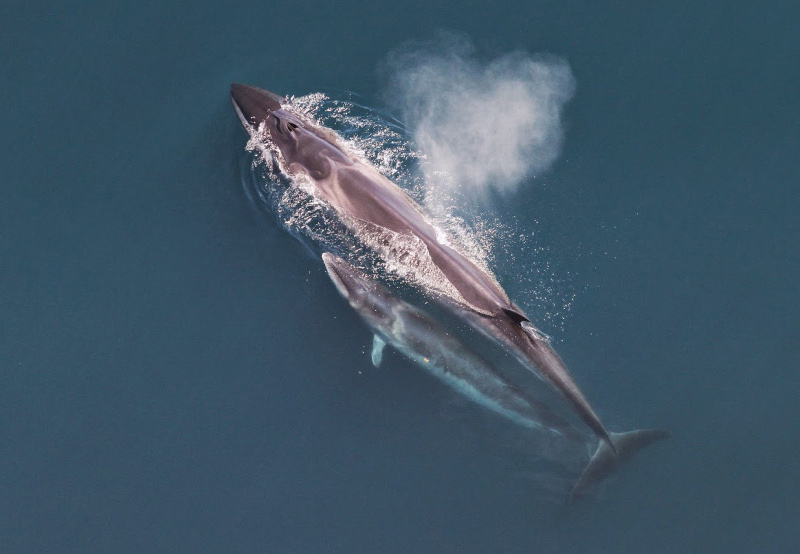
Sei Whale Facts
- The simple term of Sei Whale serves as the most frequently used common name for this remarkable mammoth of the seas. The impressive creature does have other titles, though, These include such names as the pollack whale and the Rudolphi’s rorqual.
- Within scientific circles, however, the animal’s much better known by its formal title. That’s a somewhat hard to pronounce term for the layperson, though. That’s because this wonder of evolution bears the official moniker of the Balaenoptera borealis.
- The mammal received that name due to the efforts of the French naturalist, René-Primevère Lesson. He accomplished the first official recognition of it as a separate and distinct species. He managed this scientifically noteworthy deed in the year 1828.
- It’s a massive species, ranking as the third largest extant animal on the planet. Despite its great size, though, it’s also one of the fastest of all cetaceans. Fortunately, this wonder of Nature and evolution is now protected by multiple international treaties.
- Even though it now enjoys protection, it still has a population base that’s significantly smaller than in previous centuries. That lamentable condition extends throughout the entirety of its natural range. The IUCN, thus, now lists it as Endangered on its Red List.
- It faces multiple threats to its continued existence. Most of these stem either directly or indirectly from the actions of humans. Illegal hunting still continues in some regions. Its greatest danger, though, most likely comes from ongoing climate change.
Related Articles
Sei Whale Physical Description
The magnificent Sei Whale easily impresses those individuals fortunate enough to view one. Unlike some creatures, however, they do so for more than just one reason. This masterpiece of evolution garners attention due to both its beauty and sheer physical measurements.
Like many of its relatives, it also displays a certain degree of the physiological characteristic of sexual dimorphism. In its specific case, that trait manifests itself in terms of pure size. More precisely, females of the species attain a greater size than their male counterparts.
Intriguingly, sizes of both genders varies depending upon what portion of its range they live in. Overall, though, males attain a maximum average length of approximately 61 ft (18.6 m). In the same region of the globe, females reach an average length equaling 64 ft (19.5 m).
Weights also vary between the different portions of its range, in both genders. But, in general, individuals weight between 33,069 – 44,093 lb (15,000 – 20,000 kg). Exceptional individuals do occur, of course, regardless of gender. Few exceed these sizes by much.
In terms of appearance, both sexes of the Sei Whale present the same general color scheme. The majority of the body displays a dark, steel gray hue. The underside, though, often presents small, irregular white or light gray markings, as well as sometimes the front.
The beak of the impressive creature usually develops as highly pointed in shape. The pectoral fins of the animal also develop as comparatively short. Each further displays a sharply pointed tip. It also possesses a pair of blowholes, just like most other baleen whales.
- Kingdom: Animalia
- Phylum: Chordata
- Class: Mammalia
- Order: Artiodactyla
- Family: Balaenopteridae
- Genus: Balaenoptera
- Species: B. borealis
Sei Whale Distribution, Habitat, and Ecology
The intrepid Sei Whale evolved as native to an extraordinary range of the marine waters of the world. That’s due to the fact that it appears in most oceans of the earth, as well as adjoining seas. The animal does, though, generally avoid tropical and polar waters.
Like many of its relatives, it additionally engages in seasonal migrations. Individuals typically relocate from colder to warmer regions for winter, and cooler one’s for summer. Even today, however, researchers remain uncertain of the precise routes the amazing whales take.
The majestic Cetacean also displays decided preferences in its choice of precise habitat. Due to this pattern, the vast majority of sightings occur in deeper marine regions. Individuals rarely stray into shallower regions near shore, or even semi-enclosed bodies of water.
Most commonly, this marvel of the seas travels singly. Small pods do form sometimes, though usually temporarily. When such groups do form, they rarely exceed six individuals. Researchers still know very little about the social structure of such short-term groups.
The Sei Whale evolved as a filter feeder, again like many of its relatives. Each specimen consumes an average of 2,000 lb (907 kg) of food per day. Its filtering action primarily catches vast quantities of zooplankton, along with a small number of tiny fish.
Mating occurs in either temperate or subtropical waters during the winter period. Females typically give birth to a single calf, most commonly every 2 – 3 years. Both genders reach sexual maturity at 8 – 10 years of age. A typical lifespan for both sexes is roughly 65 years.
Species Sharing Its Range
Check out our other articles on 3 Awesome Trees of Australia, Wilson’s Bird-of-paradise, Great Barrier Reef, American Sweetgum, West Indian Ocean Coelacanth, Jackson’s Chameleon
